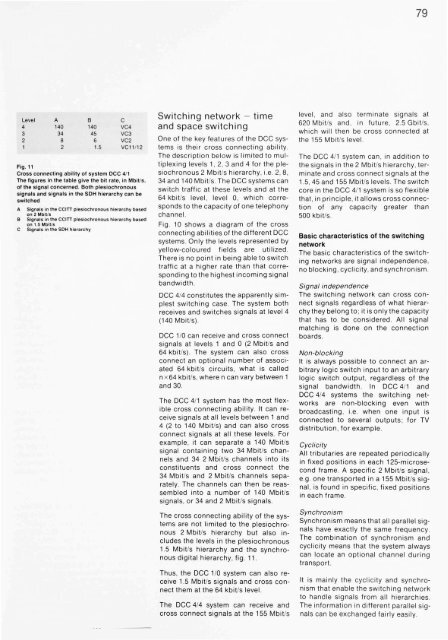Transport Network Development - ericssonhistory.com
Transport Network Development - ericssonhistory.com
Transport Network Development - ericssonhistory.com
- No tags were found...
You also want an ePaper? Increase the reach of your titles
YUMPU automatically turns print PDFs into web optimized ePapers that Google loves.
79Level A B C4 140 140 VC43 34 45 VC32 8 6 VC21 2 1.5 VC11/12Fig. 11Cross connecting ability of system DCC 4/1The figures in the table give the bit rate, in Mbit/s,of the signal concerned. Both plesiochronoussignals and signals in the SDH hierarchy can beswitchedABCSignals in the CCITT plesiochronous hierarchy basedon 2 Mbit sSignals in the CCITT plesiochronous hierarchy basedon 1.5 Mbit/sSignals in the SDH hierarchySwitching network - timeand space switchingOne of the key features of the DCC systemsis their cross connecting ability.The description below is limited to multiplexinglevels 1, 2, 3 and 4 for the plesiochronous2 Mbit/s hierarchy, i.e. 2, 8,34 and 140 Mbit/s. The DCC systems canswitch traffic at these levels and at the64 kbit/s level, level 0, which correspondsto the capacity of one telephonychannel.Fig 10 shows a diagram of the crossconnecting abilities of the different DCCsystems. Only the levels represented byyellow-coloured fields are utilized.There is no point in being able to switchtraffic at a higher rate than that correspondingto the highest inco mi ng signalbandwidth.DCC 4/4 constitutes the apparently simplestswitching case. The system bothreceives and switches signals at level 4(140 Mbit/s).DCC 1/0 can receive and cross connectsignals at levels 1 and 0 (2 Mbit/s and64 kbit/s). The system can also crossconnect an optional number of associated64 kbit/s circuits, what is callednx64 kbit/s, where n can vary between 1and 30.The DCC 4/1 system has the most flexiblecross connecting ability. It can receivesignals at all levels between 1 and4 (2 to 140 Mbit/s) and can also crossconnect signals at all these levels. Forexample, it can separate a 140 Mbit/ssignal containing two 34 Mbit/s channelsand 34 2 Mbit/s channels into itsconstituents and cross connect the34 Mbit/s and 2 Mbit/s channels separately.The channels can then be reassembledinto a number of 140 Mbit/ssignals, or 34 and 2 Mbit/s signals.The cross connecting ability of the systemsare not limited to the plesiochronous2 Mbit/s hierarchy but also includesthe levels in the plesiochronous1.5 Mbit/s hierarchy and the synchronousdigital hierarchy, fig. 11.Thus, the DCC 1/0 system can also receive1.5 Mbit/s signals and cross connectthem at the 64 kbit/s level.The DCC 4/4 system can receive andcross connect signals at the 155 Mbit/slevel, and also terminate signals at620 Mbit/s and, in future, 2.5 Gbit/s,which will then be cross connected atthe 155 Mbit/s level.The DCC 4/1 system can, in addition tothe signals in the 2 Mbit/s hierarchy, terminateand cross connect signals at the1.5, 45 and 155 Mbit/s levels. The switchcore in the DCC 4/1 system is so flexiblethat, in principle, it allows cross connectionof any capacity greater than500 kbit/s.Basic characteristics of the switchingnetworkThe basic characteristics of the switchingnetworks are signal independence,no blocking, cyclicity, and synchronism.Signal independenceThe switching network can cross connectsignals regardless of what hierarchythey belong to; it is only the capacitythat has to be considered. All signalmatching is done on the connectionboards.Non-blockingIt is always possible to connect an arbitrarylogic switch input to an arbitrarylogic switch output, regardless of thesignal bandwidth. In DCC 4/1 andDCC 4/4 systems the switching networksare non-blocking even withbroadcasting, i.e. when one input isconnected to several outputs; for TVdistribution, for example.CyclicityAll tributaries are repeated periodicallyin fixed positions in each 125-microsecondframe. A specific 2 Mbit/s signal,e.g. one transported in a 155 Mbit/s signal,is found in specific, fixed positionsin each frame.SynchronismSynchronism means that all parallel signalshave exactly the same frequency.The <strong>com</strong>bination of synchronism andcyclicity means that the system alwayscan locate an optional channel duringtransport.It is mainly the cyclicity and synchronismthat enable the switching networkto handle signals from all hierarchies.The information in different parallel signalscan be exchanged fairly easily.
















